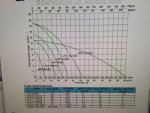[FONT="]I’m looking to install an AG pool this spring, ~15,000 gallons. I’ve dozed the site and am ordering a pool soon. I’m looking at a DC VS pump that is 500 watts (2/3hp), or one that is 900 watts, (about 1.20 hp.) (I’m off the grid by the way!) The 500 watt pump, supposedly pumps maximum 4400 gallons per hour. I’m sure with 0 head. Max head is 50 feet. The pump of course will be below the surface of the water, but of course filters can and do restrict the flow, so the actual head will be something more than 0. I’m planning on running the pump basically whenever there is sun, which will be at least 8 hours a day. My understanding is that if I circulate the water in the pool once a day, I’m more than fine. 4 hours would be adequate, IF indeed I got 4,000 gallons per hour pumped. My question is what is the normal flow rate one might expect from such a pump IN a normal system? I’m leaning toward a cartridge filter system, and can maintain it and change it when needed, and will go for the largest filter I can, (less resistance), and I also intend to go to a swcg system. Thus I'll probably be running the pump more for CL generation that for debris removal I guess?[/FONT]
[FONT="]I don’t know if this is enough information for someone to tell me if I need to go for the 900 watts or that the 500 is enough? [/FONT]
[FONT="]There isn’t much difference in cost between the two pumps, but the difference is quite a bit when you start talking about the solar panels for the different pumps. So it would be “nice” if the 500 watt pump were adequate. I assume the fact that it is variable speed will help. [/FONT]
[FONT="]Thanks for any advice. [/FONT]
[FONT="]paul[/FONT]
[FONT="]I don’t know if this is enough information for someone to tell me if I need to go for the 900 watts or that the 500 is enough? [/FONT]
[FONT="]There isn’t much difference in cost between the two pumps, but the difference is quite a bit when you start talking about the solar panels for the different pumps. So it would be “nice” if the 500 watt pump were adequate. I assume the fact that it is variable speed will help. [/FONT]
[FONT="]Thanks for any advice. [/FONT]
[FONT="]paul[/FONT]


